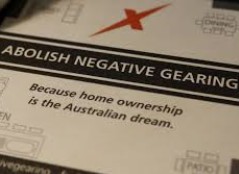
Reports have emerged that the Government is seriously considering reforming Australia’s negative gearing rules, by grandfathering arrangements for existing investors and potentially only allowing negative gearing on newly constructed dwellings. From SBS News:
Government sources say one of the changes being considered by Treasury is the grandfathering of arrangements for existing investors, but limiting future access to negative gearing so only new properties will be eligible.
It is understood Treasury and the Parliamentary Budget Office have done work in this policy area in recent months…
The scheme was originally put in place to boost Australia’s housing stock, but it has had the effect of driving up property prices and rent.
In 1985, when the Hawke government made changes to the scheme, the then-treasurer Paul Keating described negative gearing as a way for high-income earners to “swap flats on Bondi Beach which were built 40 years ago”.
And it remains true. In 2013, only about eight per cent of the money funding the scheme went towards new dwellings, with the remainder for established homes and apartments.
Limiting negative gearing to new homes and apartments would refocus the policy to add to Australia’s housing stock rather than drive up the price of existing housing…
“Quarantining is where the loss on an investment can’t be used in the year it is made, but can be used in future years against profits from the same investment from which the loss arose,” explains University of NSW tax expert Dale Boccabella…
The Housing Industry Association says any reduction in negative gearing benefits would have a “marked negative impact on the demand for housing”.
It would also worsen rental affordability through a reduced supply of investment housing.
Obviously, reforms of this nature would be a wonderful development, not just for housing affordability, but also the Budget.
According to the Grattan Institute, quarantining negative gearing losses would save the Budget around $4 billion per year initially, falling to a saving of around $2 billion per year over the longer-term.
It would also remove some speculative demand from the housing market, taking the pressure off prices, improving housing affordability, and increasing the rate of home ownership.
The HIA’s claim that the removal of negative gearing would reduce the supply of rental affordability is also complete bunkum.
Reserve Bank of Australia (RBA) data clearly shows that the overwhelming majority of investors – almost 95% – buy pre-existing dwellings, not newly built dwellings, and that the proportion of investors buying new dwellings has fallen spectacularly since negative gearing was re-introduced in September 1987 (see next chart).
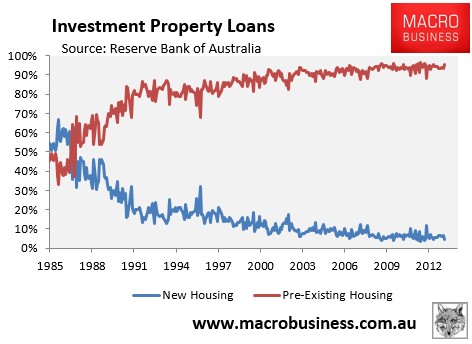
Moreover, the amount of investor funds going into new housing has barely shifted in 25 years, whereas investment in pre-existing dwellings has skyrocketed:
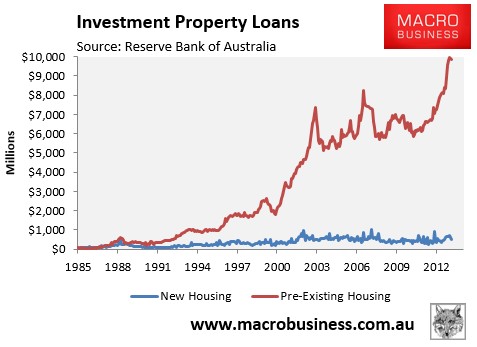
And since investors primarily purchase pre-existing dwellings, negative gearing in its current form simply substitutes homes for sale into homes for let. As such, negative gearing has done little to boost the overall supply of housing or improve rental supply or rental affordability.
In the event that negative gearing was once again quarantined and a proportion of investment properties were sold, who does the HIA think they would sell to? That’s right, renters. In turn, those renters would be turned into owner-occupiers, reducing the demand for rental properties and leaving the rental supply-demand balance unchanged.
Nor would rents rise due to the policy change. The below chart plots the Australian Bureau of Statistics (ABS) rental series from 1972, with the period where negative gearing losses were last quarantined (i.e between June 1985 and September 1987) shown in red. As you can see, there was nothing spectacular about this period, with much higher rental growth recorded in earlier periods when negative gearing was in place: 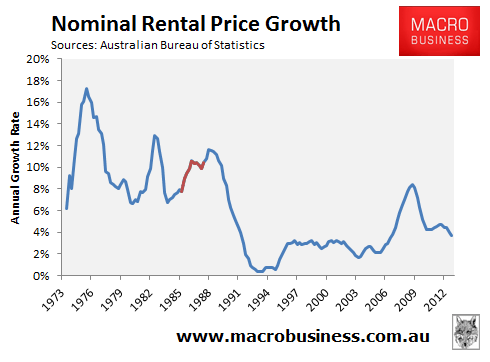
Similarly, if we deflate the above series by CPI, in order to remove the effects of inflation, we again see that rental growth over the period when negative gearing was last quarantined was nothing special, with periods of higher rental growth recorded both prior to and subsequently:
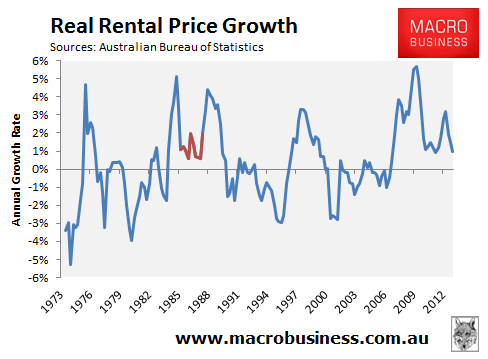
In short, negative gearing is costing the government billions in lost tax revenue, but is doing absolutely nothing to boost supply. It also creates additional demand from tax subsidised investors, placing upward pressure on home prices and locking-out would-be first time buyers.
There is little policy rationale in favour of keeping negative gearing in its current form, whose foregone funds could instead be used to fund schools, hospitals, housing-related infrastructure, or any number of other worthwhile endeavours.
The Government would do well to ignore the screams from vested interests, like the HIA, which seems only concerned about protecting the value of its member’s land banks, rather than actually boosting supply.

